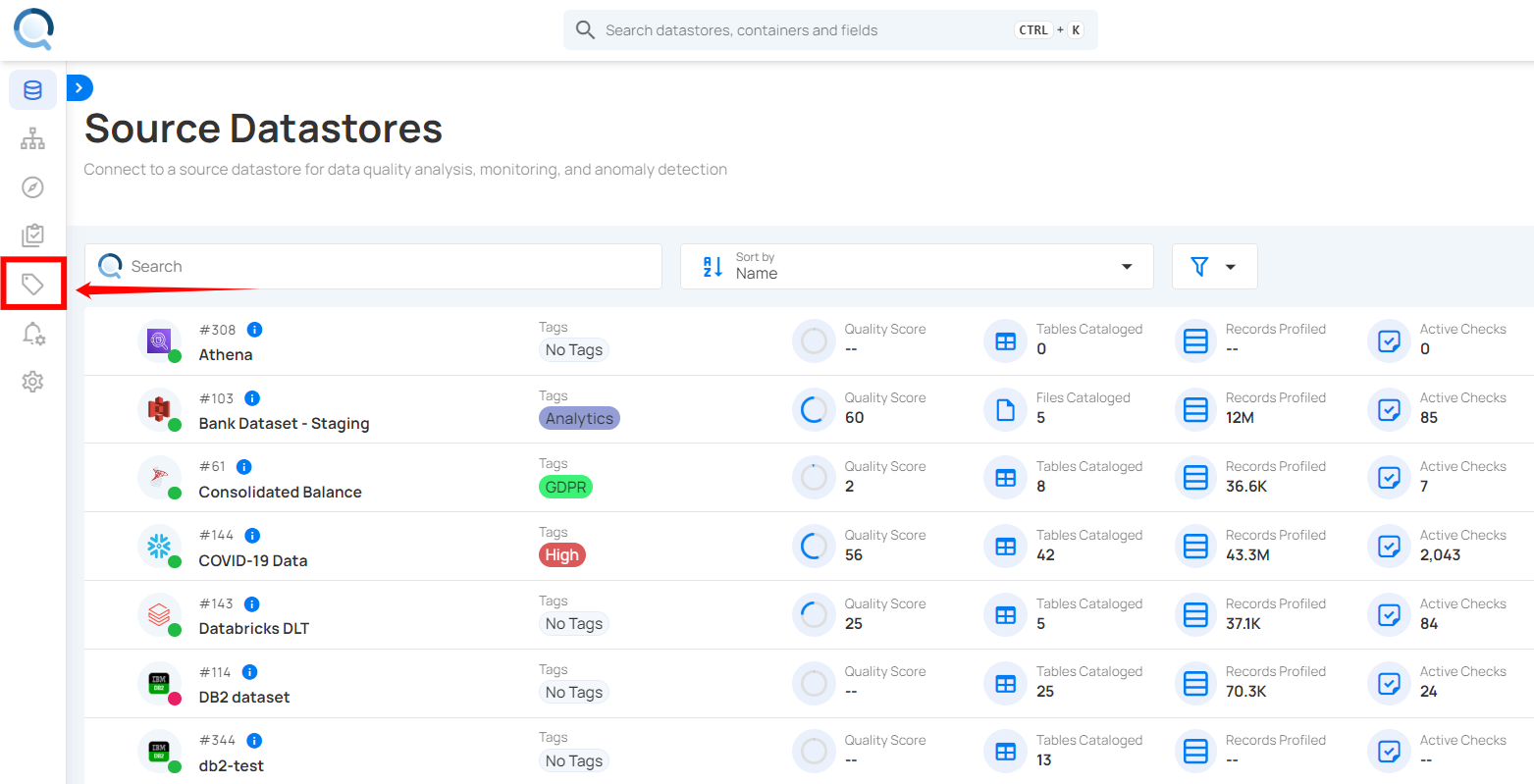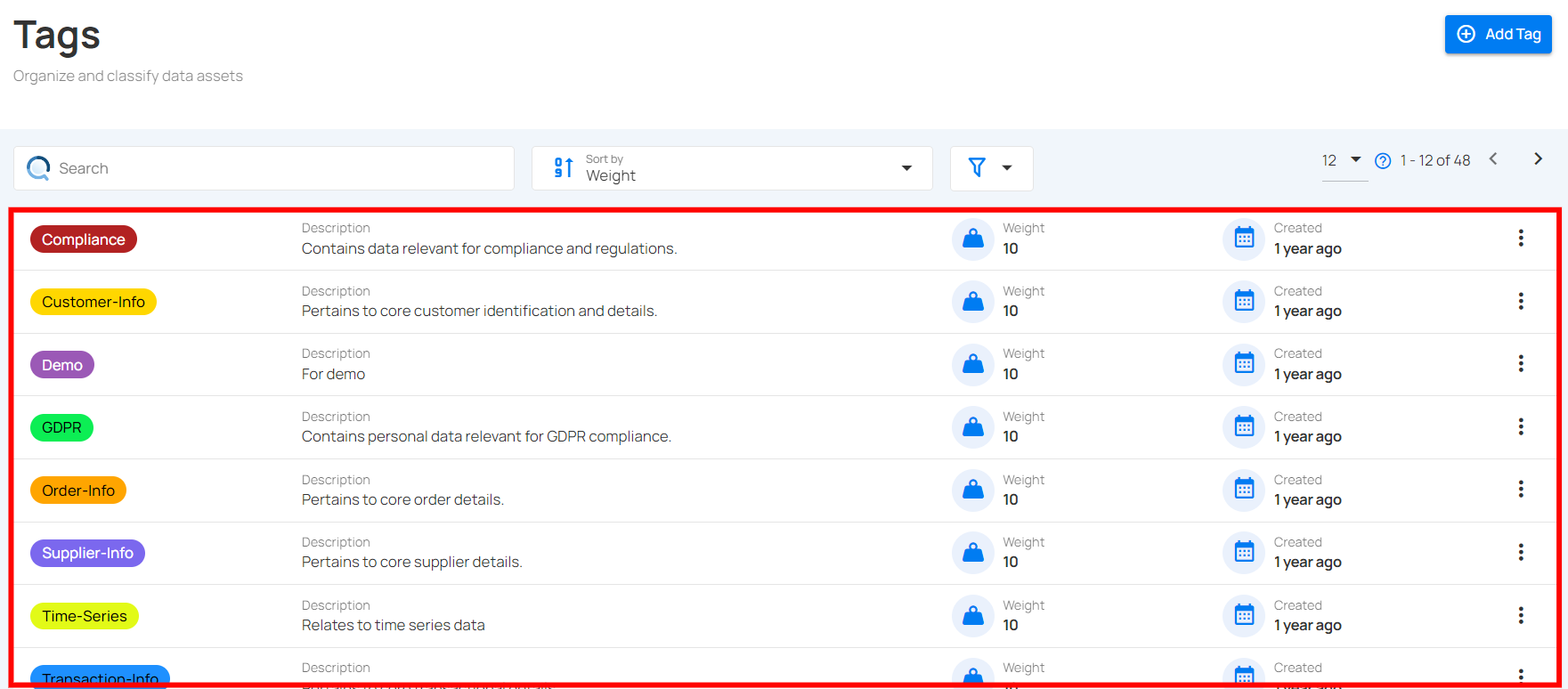Tags
Tags allow users to categorize and organize data assets effectively and provide the ability to assign weights for prioritization. They drive notifications and downstream workflows, enabling users to stay informed and take appropriate actions. Tags can be configured and associated with specific properties, allowing for targeted actions and efficient management of entities across multiple datastores.
Tags can be applied to Datastores, Profiles, Fields, Checks, and Anomalies, streamlining data management and improving workflow efficiency. Overall, tags enhance organization, prioritization, and decision-making.
Let’s get started 🚀
What Are Tags and Why They Matter
A Tag is a reusable label that you can assign to Datastores, Profiles, Fields, Checks, and Anomalies.
Tags bring consistency, context, and automation to your data workflows.
Why We Use Tags
Without tags, managing hundreds of data assets quickly becomes difficult. Tags help you:
- Categorize assets logically (e.g.,
Finance,PII,Deprecated). - Identify priorities by applying weight values.
- Filter views and dashboards for faster navigation.
- Automate responses in Flows (e.g., alert when a “Critical” check fails).
- Enforce governance by grouping data by sensitivity or ownership.
In short, Tags help you find what matters faster and act automatically based on context.
How Tags Work
Tags can be applied across the full data hierarchy in Qualytics:
- Datastore level: Applies to the entire data source and cascades to all related assets.
- Container (Table/View): Inherits from the parent datastore and passes tags to its fields and checks.
- Field: Reflects any inherited or directly applied tags.
- Check: Inherits from the container or datastore; defines context for anomalies.
- Anomaly: Inherits tags from the failed check when it’s created.
Tag Inheritance
Inheritance ensures consistency:
- If a tag named Critical is applied to a Datastore, it automatically applies to all its Containers, Fields, and Checks.
- When a Check fails, the resulting Anomaly inherits the same Critical tag.
- If you remove the Critical tag from the parent datastore, all child assets lose that tag.
- However, existing Anomalies keep the tag they inherited when they were created (no retroactive removal).
Note
Tag inheritance occurs only downward (from parent to child).
Anomalies inherit tags at creation time only — subsequent tag updates do not propagate automatically.
Real-Life Example
Imagine your organization manages multiple Datastores — Customer Data, Transactions, and Logs.
Here’s how Tags make this easier:
- You apply a PII tag to all fields containing personal data (e.g., email, phone).
- You apply a Finance tag to your Transactions datastore, which cascades to all related fields and checks.
- You assign a Critical (Weight: 10) tag to checks that monitor payment processing errors.
Now your team can:
- Filter anomalies by tag (e.g., view only “Critical” issues).
- Trigger Flows for specific tags (e.g., auto-alert the Finance team).
- Generate reports grouped by classification (e.g., all PII fields).
Tags turn scattered data into a structured, actionable map of your ecosystem.
Understanding Weight Modifier
Each tag includes a Weight Modifier — a numeric value between –10 and +10 that represents its relative importance.
| Range | Purpose | Example |
|---|---|---|
| –10 to –1 | Low priority | Deprecated or test data |
| 0 | Neutral | Informational or general tags |
| +1 to +10 | High priority | Critical, PII, or Production data |
How Weight Affects the System
- In Dashboards: Higher-weight tags appear first in sorted lists and visualizations.
- In Checks: High-weight tags help prioritize anomaly reviews and notifications.
- In Flows: Tags can be used to trigger automated actions for higher-priority data.
Note
Weight values affect prioritization and filtering, not computation or scoring.
Scope: User-Level or System-Level?
Tags in Qualytics are system-wide, not user-specific.
Once created, a tag becomes available for all users who have permission to view or apply it.
Types of Tags
- Global Tags: Created manually inside Qualytics. Editable by permitted roles and visible to all teams.
- External Tags: Imported automatically from integrated catalog systems like Atlan or Alation.
These cannot be edited or deleted in Qualytics and remain read-only.
Use Cases
| Scenario | Example | Benefit |
|---|---|---|
| Data Classification | Tag all personal data fields with PII. |
Simplifies privacy compliance checks. |
| Operational Priority | Tag high-risk checks as Critical (Weight: 10). |
Drives targeted alerts and prioritization. |
| Lifecycle Management | Tag outdated datasets as Deprecated. |
Makes cleanup easier and safer. |
| Automation | Configure Flows to run only for Finance tags. |
Enables targeted workflows. |
Permissions and Security
Tag permissions are determined by Team Roles in the Qualytics security model.
Permission Matrix for Tags
Legend:
✅ → The role can perform the action
❌ → The role cannot perform the action
| Action | Reporter | Viewer | Drafter | Author | Editor |
|---|---|---|---|---|---|
| Create Tag | ❌ | ❌ | ❌ | ❌ | ✅ |
| Edit / Delete Tag | ❌ | ❌ | ❌ | ❌ | ✅ |
| Apply Existing Tag | ✅ | ✅ | ✅ | ✅ | ✅ |
| View Tag | ✅ | ✅ | ✅ | ✅ | ✅ |
Tags in Flows
Tags can be used in Flow configurations to trigger or filter actions.
Example Use Cases
- Run a Flow only for Checks tagged “Critical.”
- Send Slack alerts for Anomalies tagged “PII.”
- Trigger Data Export for Datastores tagged “Finance.”
Tags act as metadata filters that determine which entities are included or excluded in automated workflows.
Navigation to Tags
Step 1: Log in to your Qualytics account and click on the Tags on the left side panel of the interface.

You will be navigated to the Tags section, where you can view all the tags available in the system.

Add Tag
Note
For more steps please refer to the add tag documentation.
Applying a Tag
Note
For more steps please refer to the applying a tag documentation.
External Tag
Note
For more information refer to the external tag
Filter and Sort
Note
For more steps please refer to the filter and sort documentation.
Edit Tags
Note
For more steps please refer to the edit tag documentation.
Delete Tags
Note
For more steps please refer to the delete tag documentation.